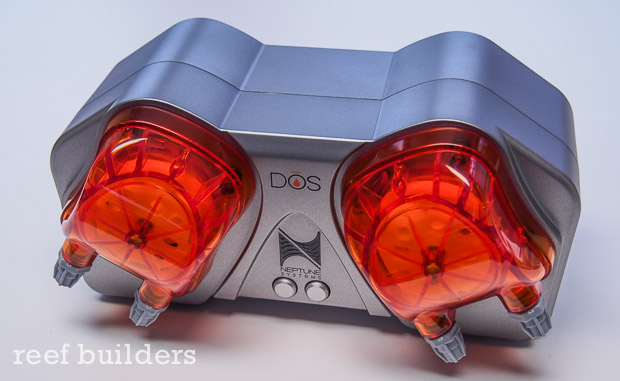The DoS Fluid Metering System from Neptune Systems was one of the company’s most exciting new product announcements at MACNA last year, and a lucky few early adopters received their new device right at the closing of the year. We received a unit to review ourselves and before taking it through its paces, we decided to see what was under the hood for a good old fashioned teardown.
It’s been quite a while since we’ve disassembled a marine aquarium product. LED lights aren’t really sporting any new surprises these days but with Neptune Systems making such a fuss about their new approach to controlled fluid dosing, or metering, we really wanted to see how the DoS Fluid Metering pump was constructed from the ground up.

Unlike the WaV or Automatic Feeding System, the DoS is a completely new housing and internals built from the ground up for a truly unique design in transporting fluids in a controlled way from one place to another. It’s one thing to look at a DoS sitting on a shelf at a conference or to go step by step through Neptune’s very thorough powerpoint of all the new features of the DoS, but it’s another to go through every feature by taking the whole machine apart.

We knew the internals of the DoS would be fairly simple, but the way the whole thing is assembled is quite impressive. The first thing users will notice is two very large pump heads on the front of the device, each of which easily snaps off for easy maintenance and servicing of the peristaltic tubing.
The pump heads have a mechanical rather than pressure-dependent shaft transfer of the torque from the beefy motors so that slippage is not possible. Once we got our machine all set up and in place we realized that not only could we remove the pump heads for servicing, we could also disconnect both pump heads and remove the machine for servicing without having to undo any of our tubing connections.

All of the power and control ports of the D0S are located on the bottom side of the left face with a pair of USB ports to daisy chain via Aquabus, and there’s a spot there for a 1Link connection as well as accessory ports for reporting back the fluid levels in the forthcoming DoS “smart” dosing containers.
We really hope the smart feedback feature will be accessible to simple float switches that users can install on any sort of container to sense the water levels of aquariums, sumps, and storage containers to greatly expand the functionality of the overall DoS system.

One thing which does stand out about the DoS is its relatively large size compared to other dosing pump systems. The DoS is comparatively much larger for just two channels of fluid dosing but this is necessary to fit the large and powerful stepper motors used to provide very precise and accurate dosing of fluids, even at very small volumes. Thankfully the large size of the DoS is somewhat offset by its ability to comfortably stack a feature built right into the shape of the housing itself.

The oversized stepper motors really are something with an incredible range able to dose fluids practically drop by drop or even for moderate amounts of water changing. The super fine dosing possible with the DoS enables the automated dosing of concentrated supplements like those from ZeoVit which call for one drop per 25 gallons per day. Additionally the DoS is capable of doing automatic water changes with an exchange rate of up to one gallon every 15 minutes.
With such beefy internals under the hood of the DoS metering system, the fluid metering capabilities of this device go well beyond the typical dosing pump and are more into the territory of a whole new platform for doing cool things for our aquariums. One early adopter has conceived a very novel method for automatically “dosing” frozen food to his aquarium and there’s really no limit to what is possible with it. Stay tuned for a full feature of how we’ve installed the Dos Fluid Metering System for a very novel aquarium application and definitely let us know what creative uses for the DoS you’ve come up with.







